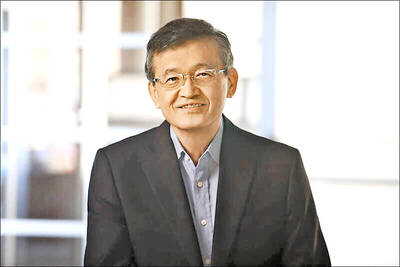Taiwan’s economy is set to receive a substantial boost this year from Taiwan Semiconductor Manufacturing Co’s (TSMC, 台積電) unprecedented spending spree, as the chipmaking giant accelerates plans to build more factories.
Taiwan’s largest company revealed plans earlier this month to spend between US$40 billion and US$44 billion this year on new plants to help ease the shortage of semiconductors. That is equivalent to about 5 percent of Taiwan’s US$760 billion economy, based on the government’s GDP estimates for 2021.
While a portion of TSMC’s capital expenditure goes overseas, the majority is spent at home to expand factories to make its highly sought-after semiconductors.
Winston Chiao, an economist at Taipei-based Taishin Securities, said that TSMC’s spending plans prompt him to upgrade his most recent forecast of 4.2 percent GDP growth this year.
“TSMC’s US$30 billion outlay on capex last year triggered a series of investment spending and new factory construction in all the companies in its supply chain, such as steel, chemicals and other raw materials,” he said on Wednesday.
Taiwan’s GDP grew 6.28 percent last year, the Directorate-General of Budget, Accounting and Statistics (DGBAS) said. That was the fastest rate of expansion since the rebound in 2010 after the global financial crisis.
Growth was predominantly fueled by a stellar year for Taiwan’s exporters. Global demand for semiconductors and other electronic products surged, driven by rebounding consumer spending as most countries eased their COVID-19 lockdowns through the year.
Corporate revenues reflected this, with the combined annual sales of companies on the Taiwan Stock Exchange rising 15 percent to a record NT$38.2 trillion (US$1.37 trillion), according to a statement from the bourse.
The benchmark TAIEX reached multiple record highs throughout the year, and the Taiwan dollar hit a new 24-year high.
The main risk for the economy this year is whether the government adopts strict new measures to stamp out a new COVID-19 outbreak.
Domestic consumption is forecast to have rebounded in the fourth quarter of last year after a partial lockdown in the spring and summer shut down entertainment venues and banned in-restaurant dining.
Renewed restrictions could risk further exacerbating growing imbalances between sectors that rely on domestic consumption and thriving export industries, Natixis SA’s Asia-Pacific chief economist Alicia Garcia Herrero said.
“This divergence in growth has begun to affect wages and inflation,” she wrote in a report released on Wednesday. “Sectors related to global trade, such as semiconductors and shipping, have enjoyed high wage growth, while the services sector is in a parallel universe.”
She said that Taiwan’s economy could face non-export sectors being unable to keep pace with the tech industry, leading to rising inequality.
The government is projecting domestic consumption to rise 5.36 percent this year.
“With fewer and fewer countries aiming for COVID-zero and Taiwan also expected to learn to live with the virus, we will not likely go back to the lockdown stage which dragged the domestic sectors back in 2021,” Chiao said.

Intel Corp chief executive officer Lip-Bu Tan (陳立武) is expected to meet with Taiwanese suppliers next month in conjunction with the opening of the Computex Taipei trade show, supply chain sources said on Monday. The visit, the first for Tan to Taiwan since assuming his new post last month, would be aimed at enhancing Intel’s ties with suppliers in Taiwan as he attempts to help turn around the struggling US chipmaker, the sources said. Tan is to hold a banquet to celebrate Intel’s 40-year presence in Taiwan before Computex opens on May 20 and invite dozens of Taiwanese suppliers to exchange views

Application-specific integrated circuit designer Faraday Technology Corp (智原) yesterday said that although revenue this quarter would decline 30 percent from last quarter, it retained its full-year forecast of revenue growth of 100 percent. The company attributed the quarterly drop to a slowdown in customers’ production of chips using Faraday’s advanced packaging technology. The company is still confident about its revenue growth this year, given its strong “design-win” — or the projects it won to help customers design their chips, Faraday president Steve Wang (王國雍) told an online earnings conference. “The design-win this year is better than we expected. We believe we will win

Chizuko Kimura has become the first female sushi chef in the world to win a Michelin star, fulfilling a promise she made to her dying husband to continue his legacy. The 54-year-old Japanese chef regained the Michelin star her late husband, Shunei Kimura, won three years ago for their Sushi Shunei restaurant in Paris. For Shunei Kimura, the star was a dream come true. However, the joy was short-lived. He died from cancer just three months later in June 2022. He was 65. The following year, the restaurant in the heart of Montmartre lost its star rating. Chizuko Kimura insisted that the new star is still down

While China’s leaders use their economic and political might to fight US President Donald Trump’s trade war “to the end,” its army of social media soldiers are embarking on a more humorous campaign online. Trump’s tariff blitz has seen Washington and Beijing impose eye-watering duties on imports from the other, fanning a standoff between the economic superpowers that has sparked global recession fears and sent markets into a tailspin. Trump says his policy is a response to years of being “ripped off” by other countries and aims to bring manufacturing to the US, forcing companies to employ US workers. However, China’s online warriors